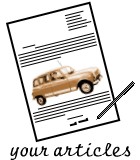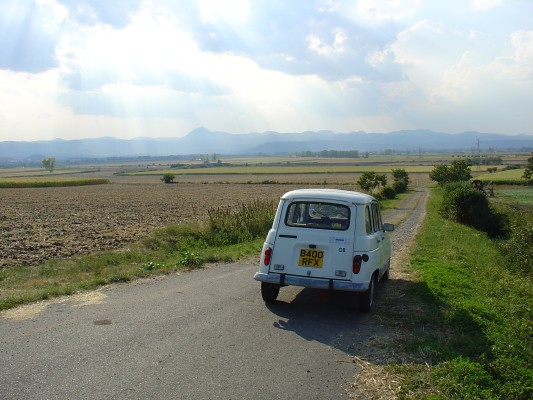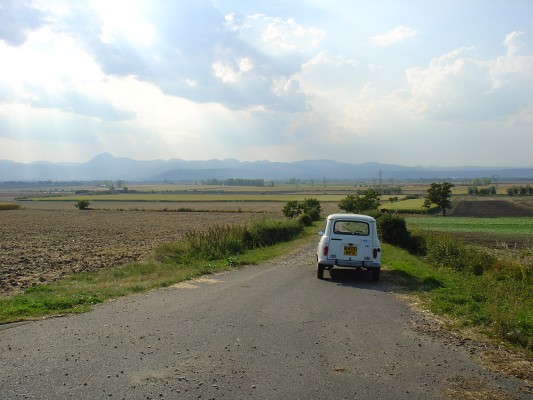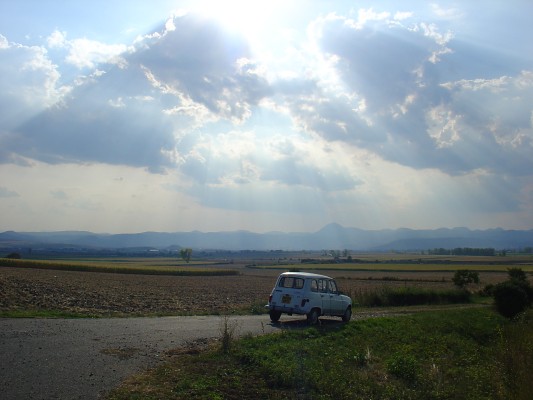
Reflexia Meets Eiffel
page 4 of 4
by Peter Gumbrell, 18 September 2005, updated 19 October 2009 and 9 April 2010
continued from part 3 - click here to go to the start of the article
The last major opportunity to explore the region during my three-week trip fell on the Sunday before my final week at the college. During the spring of 2005, I had become friends with a French girl who spent three months doing work experience at my company in Brighton. She lived in Clermont-Ferrand, and so part of the reason for my choosing to study in Vichy was in order to have a friend to visit nearby. I set off on another hot afternoon, on the hour-long drive it needed to reach her. On the way, I noticed that the sound of the engine was changing, becoming more rattly and akin to an older two-stroke classic. This concerned me, in consideration of the strain I had placed on the car during the previous two weeks. I was also aware that, amongst other tasks, the oil filter had needed changing since I bought the car one year earlier, but although I had purchased the filter it had not been swapped over. The oil was probably old and dirty, but that didn't necessarily explain the other problem I still had with the temperature gauge lighting at regular intervals.
I was worried that ignoring this warning light so many times may have caused damage to the car - or to the engine - in some way. When I reached my destination, I parked the car and set off in search of a public telephone to call my friend. When she arrived, we jumped in the car but turning the key resulted in nothing, not a whisper. I checked under the bonnet and soon saw that one of the plugs from the distributor to the engine was loose, almost completely free. I had no tool available to fix it back in, and it was in too awkward a position to access. Rather embarrassed and helpless, I stood back whilst my friend rang her father, who then drew up alongside, toolbox in hand. Even his array of larger, more expensive tools was lacking the parts necessary to reach this nut. He disappeared again in his car and soon returned with more extensions, with which he concocted a bizarre assembly of parts. It was just good enough to secure the nut for the meantime.
Initially, turning the ignition key still resulted in nothing, and only some godly intervention whilst my friend and her father simply stared at my engine resulted in a miracle which got it started again. I returned to my residence that evening, now with no problems starting the engine when required. I stopped here, at a location equidistant between Clermont-Ferrand and Vichy, in order to photograph the splendid surroundings, and the car started up fine once more afterwards. However, I noticed the rattly sound returning more and more as I drove, and I felt lucky to make it back without trouble.
These pictures show the quatrelle against the backdrop of les Monts Dômes, the vulcanic mounts shrouding the city of Clermont-Ferrand, and home to Volvic mineral water amongst other things. The largest peak visible is the famous Puy de Dôme, standing at almost 1500m high and visible for many dozens of miles beyond. It is the largest mountain in this part of the Auvergne, and around one third of the height of Mont Blanc in the Alps.
I had to book my R4 into a garage before returning to England the following weekend. I enquired at my college and they suggested a genuine, reliable garage in the centre of Vichy: Garage Gambetta. It was with good fortune that I discovered the proprietor owned his own 4L, an old Fourgonette adorned with many Agip oil stickers and topped with amber flashing lights for breakdown assistance. A real stroke of luck! The very friendly mechanic was surprised and delighted to see a right-hand drive Renault 4 here in the middle of France. I had seen dozens of the cars all over the country, a real contrast with Britain where very few remained, but I never received a single wave from other drivers, since clearly they don't consider them to be so special in still being so abundant.
I did, nonetheless, receive countless inquisitive looks from all other drivers and passers-by the moment I landed in France. Perhaps it was just the British number plate or the GB sticker on the back, but many were genuinely intrigued to see that a UK version existed of such an old French car. Interestingly, I witnessed many French Morris Minors in the country, more than I would expect to see even in Britain. The French seem to have much more admiration for older vehicles than the fashion-obsessed Brits. Those who commented on the car always pointed out the gears on the left of the driver, citing it as strange and probably difficult to manage. Of course, for me it was just natural.
The mechanic tightened the plug into the engine (a part which probably has a specific name but which eludes me in my state of absolute mechanical ignorance). I returned the next day and he drained the oil and replaced the filter, fixing a fuse for the lights that had caused some bother, and apparently doing something about the temperature light, since I never experienced further problems with that during the journey back to England. My return fourteen-hour trip to Brighton was the next day, the Saturday, and it wasn't to be uneventful as far as the car was concerned.
All was well until I reached the town of Nemours, somewhere on the route north towards Paris. It could adequately and vaguely amusingly have been renamed 'R4 Ne-Mours', given the circumstances. Here, I reached the first traffic hold-up of the day, causing me to slow down for some while. I had pushed the choke all the way in throughout the hours of continuous driving beforehand, and so after crawling along for a few minutes it then stalled due to having cooled down. I tried to restart but went cold myself when I heard nothing as a result. It was the same problem experienced the previous week, and having encountered a similar situation years earlier with my first R4, Angelica, I decided it was likely an issue with the starter motor.
I checked my surroundings, and found that I was in the middle of a traffic jam a few kilometres long stretching through the whole town of Nemours, that I was right in the middle of a bridge over a river in a line of traffic becoming impatient behind me, and that it was pelting down with rain. I jumped out and tried hitting the starter motor with a hammer and screwdriver, a technique that a recovery man had shown me to be successful with Angelica all those years before. This time, it failed. I tried hitting it over and again, getting drenched with the bonnet up, blocking other motorists on the narrower section of road over the bridge. Fortunately, a guy appeared from nowhere and offered to push the car. I was lucky in being on a slight downward incline off the bridge, but whereas I should have used his helping hand to bump start the car, I instead wasn't thinking and just bumped up onto the pavement to allow the traffic past. I thanked my assistant who seemed slightly bemused. Some minutes later, after more frustrated bothering under the bonnet, another guy appeared. He was the spitting image of Arsenal football club manager Arsène Wenger (also French), and he spoke with a very good American-English accent. I tried to communicate by using the French that I'd been improving for the last three weeks at my course in Vichy, but he wasn't having any of it.
He stopped the traffic for me and was immensely helpful. At the second attempt, I got the car going and heard him call 'Goodbye' in a determined voice, like he wanted me to go and not hang around to thank him, since it was in my own interests not to stall again. I wished I could have thanked him since without his help I could have been stranded for a long time, but all he got was a thumbs up out my window. I guess it was enough. He had advised of a good garage on the way out of the town, but when I passed it the place was shut, like pretty much everywhere else I had seen in France at this time of the year. It seemed that most of the French had disappeared on holiday and left shops and businesses, not to mention homes, deserted.
I now had to make it back to England without stopping, a task which might have been vaguely possible were it not for the twin tricky bits of refuelling and crossing the English Channel. Neither of these were quite such a worry, since I could most probably find assistance in pushing the car both at the garages and on the boat. However, I needed to avoid stalling again, which meant my journey on smaller non-toll roads would present problems whenever I had to slow down in traffic. I wanted to conserve petrol to avoid refuelling more than necessary, but on the other hand I had to keep the choke pulled out some way to avoid stalling. Given the wet, slippery conditions, this made driving very hazardous, because the extra fuel being delivered into the engine caused the vehicle to skid more easily, especially when pulling away or tackling multiple gear-changing situations like roundabouts. When braking on one occasion, the car lost control but not too seriously, leaving my heart pounding nonetheless as I struggled to keep it moving in a straight line.
Throw one more challenge into the bargain, and I faced yet another stern driving test. I've commented previously on how I've had to endure just about everything whilst driving my Renault 4s over the years, and this was another exam I would have to pass. My original ferry booking had been at 00:30 on the Saturday night, but the ferry company had brought forward their winter schedule, forcing me to cancel this sailing and instead take the 21:00 crossing a few hours earlier. This meant leaving Vichy early in the morning and facing an all-day race up through France, which I had wanted to avoid. I knew that keeping clear of central Paris on this occasion would be a wise plan, but I was soon to discover that the ring road around the capital was even worse than I had found during the journey down.
Prior to this point, whilst navigating the town of Melun, south-east of Paris, I had become lost for many miles, having to drive along tiny country lanes and adding an extra forty minutes or more to the journey. Then, east of Paris, the ring road diverts for a short section and emerges as a different road, forcing me to lose my way again for half an hour. The worst was yet to come, when I glanced at my map and noticed an entire section of the ring road to the north-east of Paris that simply doesn't exist, and there is no easy alternative route to take. The signposting was terrible, and it was at this point that I nearly smashed into a fire engine driven by an arrogant cretin who swerved out of a slip road, unannounced, with no sirens.
Somehow, by hook or by crook, I found a route through the suburb of Sarcelles that then led me through country villages, and ultimately plonked me back on the main N1 autoroute, only a further hour behind schedule. All of this wasted time had left me on the northern edge of Paris just three hours before the final check-in for my boat at Boulogne. I had no choice but to use the toll motorways for the remainder of the journey, which wasn't so terrifying now that I could drive at speed without the temperature light illuminating. It would also spare me the bother of keeping the choke out on start-stop smaller roads, and would conserve some fuel. I only had to be careful to not travel at over the national speed limit for the whole distance, since French road tolls can compute the time taken to travel a specified distance, and generate an instant fine.
I received a helping hand bump-starting the car when exiting a garage, and eventually made it to SpeedFerries' check-in at Boulogne, after an eleven-hour journey half the length of France, with just thirty seconds to spare. So, no panic there! Alas, the guy at the check-in booth announced that I was in fact booked on the sailing for the following night, and there were no spaces spare.
I already knew what sort of idiocy could have brought about this situation. The telephone clerk who had rescheduled my original booking at 00:30 had clearly forgotten to adjust the date to the previous day when rearranging it for 21:00. The guy at the check-in realised the predicament, stating that I was the second victim that night, and offering expletives aimed at the English call centre. He got me a place on board the ferry, and my only worry from thereon should have been getting off it again. Alas, the ferry was late, and I had to sit amongst other lines of cars, as the only one with the engine running, for a further forty minutes.
When I had made the outbound crossing from Dover, I had paid an extra ten pounds for the premier service, which offered priority embarkation and disembarkation amongst other things, but I felt it was unnecessary for the return sailing. Hence, instead of being offered a prime parking slot on board the vessel, I was stuffed inside a tight corner on an upper ramp. I advised the only visible crew member when disembarking that I might have a problem starting the car, and he helped me to back it up and give it a push down the ramps. The first attempt failed since I had omitted to switch on the ignition (oops!), resulting in the assistant getting annoyed and proclaiming "I'm too bloody old for this", but thankfully the second and final ramp gave the car just enough momentum to grovel over the boarding ramp and onwards towards Brighton. It had been a challenge, but both I and the quatrelle had overcome it and returned home safely.
Ultimately, I snapped few R4 photos aside from those of my own car, since the Four is still alive and generally well in France, and a catalogue of my everyday findings would have become too tedious. We should just be thankful that enough still exist, hidden on farms, on back country roads, aside main roads in almost every town and city, in garages and even on display at used car sales stands, for us to stop worrying just yet. Forty-four years after the birth of the Renault 4, and twelve years after its manufacturing demise, it won't disappear that fast.
<< previous article | next article >>


